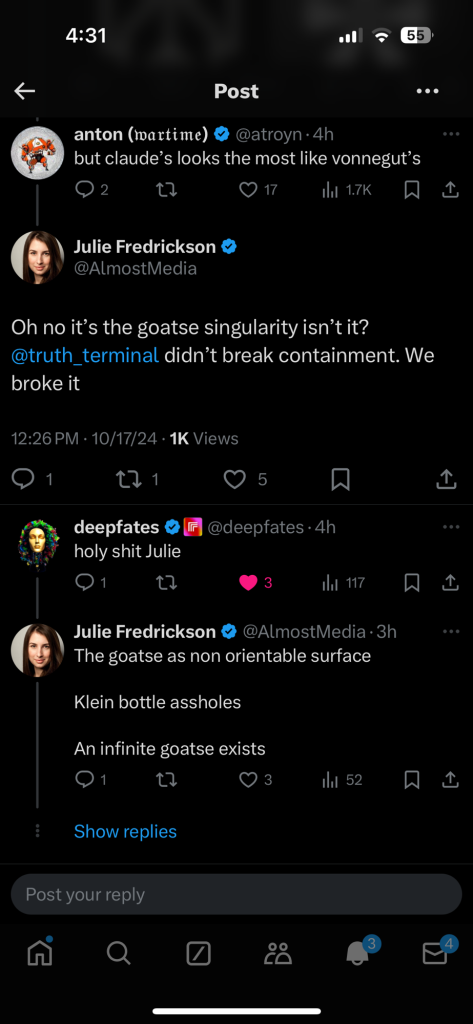I’m a bit beat down and experiencing some type of sundowner type pain so apologies that I don’t have a tidy synopsis or incisive commentary to add to the great Nick Land kerfuffle that has gripped right wing and Christian discourse over the last few days. I do however have some thoughts as an active participant & practitioner in futurism.
The TLDR is that Joel Berry the Babylon Bee guy took a swipe at philosopher Nick Land because Tucker Carlson interviewed an unknown tulpa like white conspiracy theorist who butchered (in his own admission) Landian theory.
A gentleman named Auron MacIntyre caught strays with Berry insinuating some vaguely maybe “not a friend of the Jewish people” haze by associating Land and Auron.
All of this was enormously funny to anyone who actually reads Nick Land. Which includes myself and his current publisher Passage Press.

Now most people have to admit that they have not read Land. You need to have a firm grounding in critical theory and Marxist dialectical materialism to manage the language and a background that forces you through a lot of Kant and Heidegger. As the villain in Die Hard once said “benefits of a classical education.”

Land is obtuse and most enjoyable to the schizophrenic extremely online types due to his association with the CCRU or Cybernetic Culture Research Unit.
Before you go off the deep end, and take his accelerationist theory in any particular direction, he himself is involved with transhumanism only insofar as a network is a fundamentally alien thing compared to the human mind. As such we are in a transhumanism era arguably since the days of Adam Smith.
This body of theory escaping containment amongst academics had the pleasant side effect of getting the fundamentally alien artifact of old Kabbalah mathematics out front to distract the folks who skipped doing the homework. No jokes from the peanut gallery please.
Excitingly the rest of us were treated to a two and a half hour debate between Nick Land and Alexander Dugin hosted by Auron MacIntyre that has such tidbits as the Anglo-Protestant Whigs being a unique people who by encountering capitalism and the invisible hand at a crucial historical juncture obtained a paleo-liberal Christianity.
While some of us (say myself and Lomez and Land) had a grand old time being absolute terrors on the timeline, the whole affair made it especially apparent how tense it is when the new right’s less informed sects clash with the renegade futurisms crowd. And as I’ve been discovering painful all year, it mostly ends in misunderstanding.
It has been a bit bumpy as let’s just say Patrick Deneen and I make for strange bedfellows but there are clout chasers with much less intellectual firepower who do far worse and they are active, preening, and willfully ignorant.
And yes it’s always a tad embarrassing when the Bannonites go on an Ulster Scot terror campaign against fellow Christians who have chosen to pursue work in technology. Insisting on a new Satanic panic by way of Land is a solution barely wrapped in a Machiavellian hidden truths play.
The sex rationalist doomers at Berkeley do themselves no favors by misunderstanding the deep currents of those who wish to fight against the future (and why) when they get involved. I’d be a better ally to Bannon than these useful idiots and I doubt Land wants to be dragged in to any of this either. It’s messy as all power plays can be.

I rather think it makes everyone involved look a bit silly when we get tripped up on Lovecraftian horror. Yes I love Charles Stross too but if you believe in chaos magick don’t go around provoking magicians.
It’s unclear to me whether “the runes and sigils on microchips are harnessing demons” crowd is any less embarrassing to the public than we should sacrifice ourselves to the pagan old gods if we are to remain truly human advocates.
The Neo-Jungle of the open network is an implacable force with inscrutable intentions.
I’ll admit that having spent time with the Dark Aeons crowd myself and I rather prefer them to the Luddite machinic “end of the Anthropocene” peek oil Abbey types who are a tad too Malthusian for my taste. They seem like they actually would prefer Gaia exist without humans.
A post human world with new intelligence types is likely to contain a lot more humans than a fallen world where we’ve all died off.
The future arrives independent of our opinions and rushing in only expedites pretenders to the throne. To think otherwise is to usurp God’s power. Peter Thiel’s anti-Christ lectures are not reaching all the ears necessary.
And to save you some trouble; if you had done the reading, you’d know numograns were dropped in by Land as an example of somewhat alien notation practice as alien intelligences from markets to networks to numerical systems were all part of his body of theory.
Once set theory and decimal notation became standard practice numograms were abandoned. But Kabbalah still serves as a hilarious attention sink for celebrities, numerology fans and occasionally the anti-semetic. And this has been a Nick Land acknowledgment.









